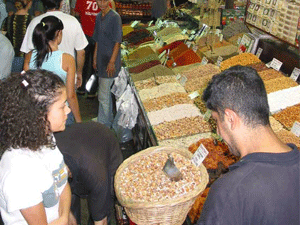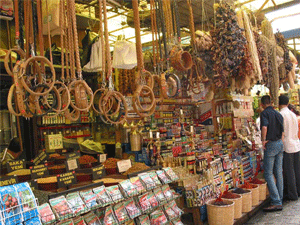Istanbul's Most Revealing Market
By Anastasia M. Ashman*
I’m bouncing along in a stream of shoppers at a neighborhood pazar, or weekly general street market. Tented for protection from the hot midday sun, this narrow Istanbul road in a residential district called Ulus is lined with merchandise that wasn’t here a few hours ago and will disappear in a few more: rows and rows of olives in plastic tubs, stands of feta cheese, and wooden carts packed with squash straight from the farm.
I’m bouncing along in a stream of shoppers at a neighborhood pazar, or weekly general street market. Tented for protection from the hot midday sun, this narrow Istanbul road in a residential district called Ulus is lined with merchandise that wasn’t here a few hours ago and will disappear in a few more: rows and rows of olives in plastic tubs, stands of feta cheese, and wooden carts packed with squash straight from the farm.
The scent of freshly baked bread wafts on the same breezes that set cotton dresses swinging at a clothing stall, while a local pop star wails on tape about lost love, supported in heartbreak by a whirling arabesque backbeat.

For a small fee, the young Turk trailing me with a basket slung over his shoulder will truck my purchases like a sherpa so I can buy far more than I can carry. Clever, I think, this traveling grocery and sundry bazaar springs from an old line.
Besides being imperial capital to Byzantine Roman and Ottoman rulers, Istanbul has long been a capital to traders, an ancient mercantile center at the crossroads of the world. Serving as the last stop on the Silk Road, a trading route carrying goods of India, China and Southeast Asia, the city distributed riches of the East to the Western world. When I began traveling to this city straddling the continents and cultures of Orient and Occident, I discovered each marketplace has its specialty.
Where the fabled and sprawling covered Grand Bazaar is often the hard-sell realm of tourist goods, springing up around mosques and main thoroughfares, other markets focus on a particular retail segment, exclusively dealing in wallpaper or barbeque sets, books or nuts.
SPICE BAZAAR
More interesting shopping excursions, if not successful buying trips, have come from wandering Istanbul’s twisted streets, perusing the goods of individual vendors who crop up along the roadside. On the Galata Bridge, which spans the Golden Horn estuary, connecting the old town center to what was once a Genoese trading concession, I spied an Anatolian grandmother in a headscarf spreading unlikely wares on a baby blue blanket: power tools.

But the market area most intriguing to me centers on a 17th century stone building along the waterfront. I head there with an open mind and an empty belly. Known as the Spice or Egyptian Bazaar (Mısır Çarşısı), the fragrant stone market boasts shops stocking a rainbow of traditional spices, medicinal herbs and confections.
Workers mind piles of dried herbs, green henna dust and clumps of oozing honeycomb while patrons sniff and taste, point and shovel. Loaded down with jellied chunks of Turkish delight or lokum, dried apricots, pistachios, and fresh marshmallows, I make my way to the waterfront entrance of the market and turn right.
There I search out the oddest items among the mundane in the Flower Market located behind the Spice Market. In a cramped passageway opening into a square, gardening supply vendors are joined by stalls catering to pet owners, workers tending mountains of animal chow, while hanging from the rafters, all manner of collars and restraints twist in the breeze. What beast requires this harness with spikes, I wonder, while satisfying myself that grass seeds feel as silky and cool as they look.
NATURAL MEDICINAL
Before I lose myself in reverie I happen upon a most memorable man whose shop consists of a chair, on which he sits. At his feet are two containers. In one, rubber-covered, millet seed-filled objects are arranged in colorful rows. I recognize them as the squeezable stress-relieving toys popular with office workers in the 1980s.
In the other crate, young half-pound bunny rabbits cower and bury themselves in a ball of fur. Children crowd around the rabbit box, reaching in and squealing with delight. If there weren’t so much competition, I might pick up a bunny. Instead I scrutinize the stoppered five-gallon jug half-filled with water at the man’s side. Inside it, writhing black leeches swim and climb. No one reaches in playfully and no one buys. Yet, the fearsome creatures must sell since the jar is heavy and the man would not lug it here if they didn’t.
As they are used in traditional medicine, the sight itself of a jar of leeches is not unusual, especially since the Spice Bazaar has historically been a center for natural medicinals. In fact, there are several bottles of aquatic blood-sucking worms for sale in this marketplace, simply sitting in the sun unattended. There must be no need to guard a vessel of carnivorous parasites. But these particular leeches are kept close, perhaps to provide the sitting man a uniformity of presentation.
As I wander over age-old cobblestones and pigeons take flight in my path, this one-man shop plays on my mind. Do his offerings reveal a brilliant diversification strategy? Are his products related in some way? If he were to add another line of goods, what would it be? This much seems clear: I have just visited the rare merchant who deals as easily and equally in the stress reducing and the blood sucking, the soft and bouncy and the slimy and flesh-crawling. And the merchant who can span the sale of these goods, whose customers have such divergent needs, sits at the crossroads of the world.
*An American based in Istanbul, Anastasia M. Ashman co-edited the #1 internationally best-selling nonfiction anthology Tales from the Expat Harem: Foreign Women in Modern Turkey.
(February 2008, Tourism Special Issue)

For a small fee, the young Turk trailing me with a basket slung over his shoulder will truck my purchases like a sherpa so I can buy far more than I can carry. Clever, I think, this traveling grocery and sundry bazaar springs from an old line.
Besides being imperial capital to Byzantine Roman and Ottoman rulers, Istanbul has long been a capital to traders, an ancient mercantile center at the crossroads of the world. Serving as the last stop on the Silk Road, a trading route carrying goods of India, China and Southeast Asia, the city distributed riches of the East to the Western world. When I began traveling to this city straddling the continents and cultures of Orient and Occident, I discovered each marketplace has its specialty.
Where the fabled and sprawling covered Grand Bazaar is often the hard-sell realm of tourist goods, springing up around mosques and main thoroughfares, other markets focus on a particular retail segment, exclusively dealing in wallpaper or barbeque sets, books or nuts.
SPICE BAZAAR
More interesting shopping excursions, if not successful buying trips, have come from wandering Istanbul’s twisted streets, perusing the goods of individual vendors who crop up along the roadside. On the Galata Bridge, which spans the Golden Horn estuary, connecting the old town center to what was once a Genoese trading concession, I spied an Anatolian grandmother in a headscarf spreading unlikely wares on a baby blue blanket: power tools.

But the market area most intriguing to me centers on a 17th century stone building along the waterfront. I head there with an open mind and an empty belly. Known as the Spice or Egyptian Bazaar (Mısır Çarşısı), the fragrant stone market boasts shops stocking a rainbow of traditional spices, medicinal herbs and confections.
Workers mind piles of dried herbs, green henna dust and clumps of oozing honeycomb while patrons sniff and taste, point and shovel. Loaded down with jellied chunks of Turkish delight or lokum, dried apricots, pistachios, and fresh marshmallows, I make my way to the waterfront entrance of the market and turn right.
There I search out the oddest items among the mundane in the Flower Market located behind the Spice Market. In a cramped passageway opening into a square, gardening supply vendors are joined by stalls catering to pet owners, workers tending mountains of animal chow, while hanging from the rafters, all manner of collars and restraints twist in the breeze. What beast requires this harness with spikes, I wonder, while satisfying myself that grass seeds feel as silky and cool as they look.
NATURAL MEDICINAL
Before I lose myself in reverie I happen upon a most memorable man whose shop consists of a chair, on which he sits. At his feet are two containers. In one, rubber-covered, millet seed-filled objects are arranged in colorful rows. I recognize them as the squeezable stress-relieving toys popular with office workers in the 1980s.
In the other crate, young half-pound bunny rabbits cower and bury themselves in a ball of fur. Children crowd around the rabbit box, reaching in and squealing with delight. If there weren’t so much competition, I might pick up a bunny. Instead I scrutinize the stoppered five-gallon jug half-filled with water at the man’s side. Inside it, writhing black leeches swim and climb. No one reaches in playfully and no one buys. Yet, the fearsome creatures must sell since the jar is heavy and the man would not lug it here if they didn’t.
As they are used in traditional medicine, the sight itself of a jar of leeches is not unusual, especially since the Spice Bazaar has historically been a center for natural medicinals. In fact, there are several bottles of aquatic blood-sucking worms for sale in this marketplace, simply sitting in the sun unattended. There must be no need to guard a vessel of carnivorous parasites. But these particular leeches are kept close, perhaps to provide the sitting man a uniformity of presentation.
As I wander over age-old cobblestones and pigeons take flight in my path, this one-man shop plays on my mind. Do his offerings reveal a brilliant diversification strategy? Are his products related in some way? If he were to add another line of goods, what would it be? This much seems clear: I have just visited the rare merchant who deals as easily and equally in the stress reducing and the blood sucking, the soft and bouncy and the slimy and flesh-crawling. And the merchant who can span the sale of these goods, whose customers have such divergent needs, sits at the crossroads of the world.
*An American based in Istanbul, Anastasia M. Ashman co-edited the #1 internationally best-selling nonfiction anthology Tales from the Expat Harem: Foreign Women in Modern Turkey.
(February 2008, Tourism Special Issue)
Last modified onSaturday, 06 May 2017 10:07
Tagged under
Latest from Admin TOA
- Fat Sal’s Italian Specialties Welcomes Customers in Bayville, NJ with a Renewed Concept
- FFD Wood LLC Delivers Custom Woodwork Solutions from Long Island
- A Tax Expert in the U.S. Tax World: An Interview with Samet Oynamıs
- Announcing the 2025 Edition of the 100 Most Influential Turkish Americans
- CEO Club New York Networking Night Stands Out with the Lamborghini Experience









